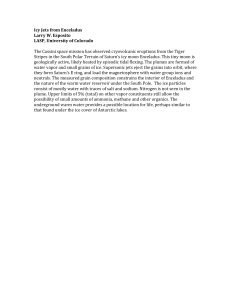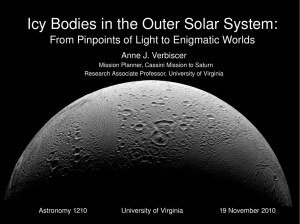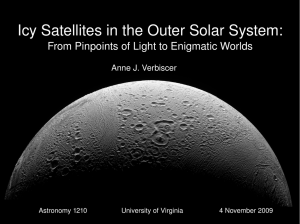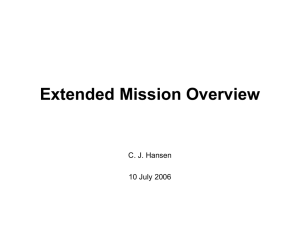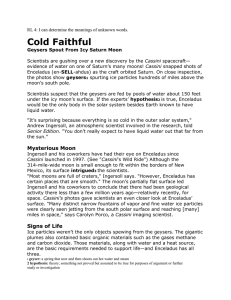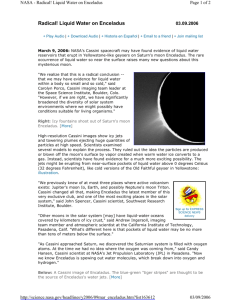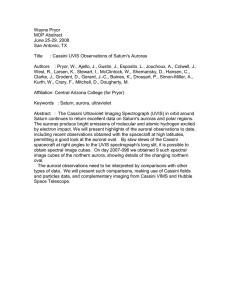Icy Bodies in the Outer Solar System: From Pinpoints of Light to Enigmatic Worlds Anne J. Verbiscer
advertisement
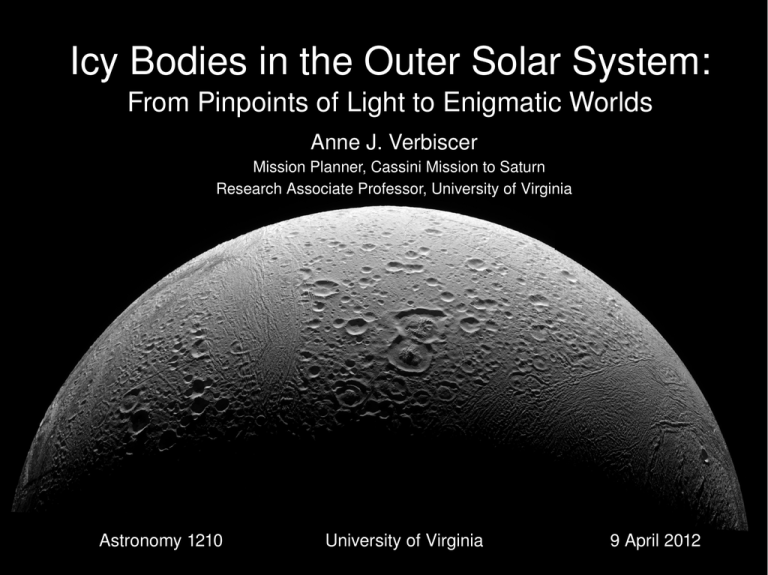
Icy Bodies in the Outer Solar System: From Pinpoints of Light to Enigmatic Worlds Anne J. Verbiscer Mission Planner, Cassini Mission to Saturn Research Associate Professor, University of Virginia Astronomy 1210 University of Virginia 9 April 2012 Our view of icy satellites has dramatically changed... To this! From this... SATURN View of Saturn (bright center) and several satellites from the 60­inch telescope on Mt. Palomar Discovered by William Herschel 28 August 1789 40­foot telescope, Slough, UK Enceladus False color mosaic of images taken by the Cassini­Huygens spacecraft in 2005. Prior to the 1970s, all we knew about outer planet moons (satellites) came from studying timy pinpoints of light seen through ground­based telescopes: Callisto Europa Io JUPITER Ganymede We thought that these moons might resemble our own..... with surfaces dominated by impact craters: Earth's Moon As an example, observe how our view of Jupiter's moon Europa improves in images acquired by the spacecraft Pioneer 10, Voyager, and Galileo: Pioneer 10 December 1973 Voyager 1979 Galileo 1995­1998 And at even higher resolution....... Very few impact craters! 30 km Europa as seen by the Galileo Spacecraft in the 1990s Ice Cliffs on Europa! 1.7 km Landslides Clearly, this does not look like our Moon... Aerial view of Providence, RI at the same scale (900 m/pixel) Icy bodies in the outer Solar System exhibit remarkable diversity: Size, shape 100­m moonlets to 10s­km potato­shaped to >1000­km spherical Visible Albedo (reflectance) Comet nuclei, some transNeptunian objects (TNOs) reflect only a few % Enceladus reflects nearly 100% of the visible light from the Sun Orbit Satellites orbit their primary (planet or TNO) at distances as large as several hundred times the radius of the planet. Orbits can be prograde (counterclockwise) or retrograde (clockwise) at various inclinations, relative to the planet or TNO equator Many are tidally locked ­ in synchronous rotation Geologic Activity Inert bodies, cratered to saturation (new craters erase old ones) Currently active worlds: Enceladus, Titan, Triton..... more? There are >160 natural satellites (moons) of giant planets and >1300 TNOs in the outer Solar System; some (3­10%) TNOs have their own moons In the outer Solar System, Ice Geology Reigns Density determines internal composition and availability of heat source from radioactive decay of rock (closer to water ice, 1 g/cm3, less rock, heat); Temperature determines type of surface geology: Morphology of impact craters Cryo­volcanic features (flows, calderas) Ice tectonics (folds, grooves, ridges, fractures) Relaxed (softened) impact craters, ridges, and fractures on Saturn's Enceladus Grooves, and ice cliffs 5 km tall on Miranda, a 230­km moon of Uranus In the outer Solar System, Ice Rocks! 5152 km 504 km Charon Active 5152 km 504 km Active Active Pluto Charon Active Weywot Vanth Jupiter's Galilean Satellites and our own Moon to scale Density (g/cm3) 3.5 3642 3.0 3038 3.3 3474 Diameter (km) 1.9 5268 1.8 4820 Jupiter's Io ­ the most geologically active satellite Volcanic plume Volcanoes powered by tidal heating Density 3.5 g/cm­3 Infrared view shows hot plumes on nightside of Io Small Moons or Large Ring Particles? Saturn's A Ring has giant propeller­like structures created by gravitational interactions with (unresolved) small (100m­1km) “moonlets” “Propeller” in Saturn's A Ring Named for Amelia Earhart Saturn's Flying­Saucer Shaped Ring Moons Atlas 45 km Pan 35 km in the Encke Gap 9 km Daphnis in the Keeler Gap just outside the A Ring Two Saturnian Ice Balls: Impact Craters Central peaks Large Basins Concentric rings 1080 km 400 km MIMAS aka 'Death Star' Density 1.15 g/cm3 TETHYS Density 0.97 g/cm3 Tethys would float! Two more Saturnian Icy Moons DIONE Density 1.5 g/cm3 1121 km 'Wispy' Terrain = fractures Only on trailing hemispheres (remember these are tidally locked and always keep the same side toward Saturn) The trailing hemisphere is centered on the moon's anti­apex of motion RHEA Density 1.2 g/cm3 1534 km Some of Saturn's Smaller Satellites Why do their surfaces look so different? Location, location, location Sharply defined craters, pits Crater rims are softened and muted HYPERION = 0.6 g/cm3 360 x 280 x 225 km Craters have been filled in by dust and ejecta TELESTO <<1 ? 29 x 22 x 20 km JANUS = 0.6 g/cm3 193 x 173 x 137 km Some of Saturn's Smaller Satellites Why do their surfaces look so different? Location, location, location Sharply defined craters, pits Crater rims are softened and muted HYPERION = 0.6 g/cm3 360 x 280 x 225 km Craters have been filled in by dust and ejecta TELESTO <<1 ? 29 x 22 x 20 km JANUS = 0.6 g/cm3 193 x 173 x 137 km JANUS and TELESTO orbit within Saturnian rings, subjecting their surfaces to repeated impacts, blasts HYPERION is further from Saturn,beyond Titan, outside such a productive impact zone Equatorial Ridge Voyager Mountains IAPETUS Density 1.1 g/cm3 Two of Uranus' icy satellites which show evidence of geologic activity: Cryovolcanic flows MIRANDA = 1.2 g/cm3 472 km ARIEL = 1.7 g/cm3 1158 km NEPTUNE'S TRITON Geysers driven by sublimation Lava lakes Has a thin, nitrogen atmosphere Density 2.1 g/cm3 2706 km Back to Enceladus.... March 1980 The Grand Tour 1981 Voyager 2 ENCELADUS Geologically young terrain, But just how young? Density ~1 g/cm3 ? Diameter 504 km Saturn Orbit Insertion (SOI) 1 July 2004 Launch 15 October 1997 2005 Cassini view of ENCELADUS Revised Density = 1.6 ! More rock in core? Does this mean more heating from radioactive decay of that rock? February 2005 Cassini ISS NAC Density 1.6 g/cm3 More relaxed craters... Fresh fractures (sharp edges) Cassini Magnetometer February, March, July 2005 November 2005 ENCELADUS is a (relatively) tiny ACTIVE moon with plumes of water ice and vapor erupting from four fractures near its south pole Temperatures (Kelvins) Heat Source? Tides? Radioactivity? (False color) Plumes at High 'Phase' (Sun­Enceladus­Cassini) Angle Particles are very forward­scattering (small size) Enceladus within Saturn's E ring Before 2005, the relationship between Enceladus and the E ring was only a theory. Enceladus (tiny black dot) In 2005, the Cassini Spacecraft observes active eruptions from the south pole of Enceladus, which feed the E ring Cassini's Enceladus Cassini Spacecraft Trajectories Flybys Near in the Prime and Enceladus 2005­2010 Equinox Missions You are here Earth ENCELADUS' 'TIGER' STRIPES Damascus Baghdad South Pole Cairo Alexandria Plume eruption sites are found along or near these four prominent fractures Alexandria Cairo Damascus Baghdad November 2009 Cross­Eye Stereo of Cairo Sulcus 8 Jets identified by triangulation South Polar Terrain A­G “hotspots” August 2008 Cassini Skeet Shoots Enceladust August 2008 Damascus Sulcus 10 km Eruption site Eruption site Damascus Sulcus Enceladan 'Fog'? ­ no direct solar illumination of surface. 13 August 2010 16 m/pixel The Cassini spacecraft sees water plumes erupting from these four warm fractures Heat emanating from these four fractures is Localized – as high as ~ 200 K ! (White = hot; Grey = cool) Damascus Sulcus Blue, purple: cooler temperatures (60 K) Yellow: hotter temperature (190 K) Warm “distal” ends of Cairo and Alexandria Sulci Encleadus' Plume Composition 90% water, 10% organics Measured by Cassini's Ion and Neutral Mass Spectrometer (INMS) Is Enceladus Like A Comet? Comet Hartley 2 Hartley 2 is MUCH smaller.... And much, much darker. Robotic spacecraft have transformed our views of icy bodies in the outer solar system from pinpoints of light to enigmatic worlds... How will our views of these pinpoints of light be transformed in 2015 when the New Horizons spacecraft flies by Pluto? Yuri Gagarin's View 12 April 1961 Where are we now, 50 years later??? ANNOUNCEMENTS Exam THIS Friday 13 April Review Session Wednesday, 11 April 4:30pm – Wilson Details given in class on Wednesday and on home page.
